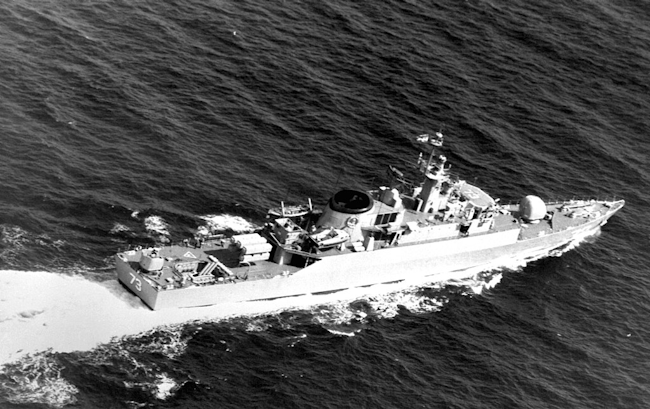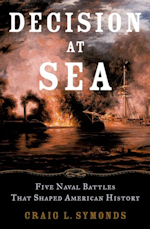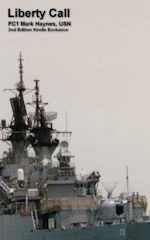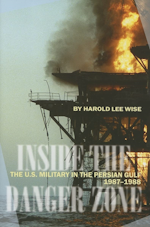Sabalan (Persian: سبلان) is an Alvand-class frigate of the Islamic Republic of Iran Navy. She was launched in 1969. Commissioned in June 1972 as part of a four-ship order, the Sabalan was originally named IIS Rostam, after Rostam, a legendary hero in the Shahnameh. It was renamed after the Islamic revolution after Sabalan, the Iranian mountain.
Sabalan in the Persian Gulf
During the Iran–Iraq War, the warship became infamous for attacks against the crews of unarmed and often neutral tankers and other merchant ships. Before these attacks, Sabalan’s captain would often board the ships and pretend to carry out a friendly inspection, sometimes even dining with the ship’s master. Then he would open fire on the ship, sometimes aiming at the ship’s bridge and living spaces.
Often, the captain would radio his victims “Have a nice day” as Sabalan departed. These actions earned the captain the nickname “Captain Nasty”.

A starboard quarter view of the Iranian frigate ITS Rostam (DE-73), later renamed IS Sabalan (F-73)
Following the spillover of the conflict onto the Persian Gulf, the United States deployed warships in 1987 and 1988 to protect reflagged Kuwaiti shipping in the Persian Gulf. During the convoy operations, dubbed Operation Earnest Will, an Iranian mine severely damaged a U.S. frigate. U.S. forces mounted a one-day retaliation called Operation Praying Mantis.
The operation’s objectives were to destroy two Iranian oil platforms used for drilling and attack coordination and one unspecified Iranian warship.
VA-95 versus the Sabalan
Discovery of the IS Sabalan
On the morning of April 18, 1988, after the oil platforms were knocked out by SAG Bravo. U.S. forces then turned it’s attention to the hunt for Iranian frigates in the Strait of Hormuz. IS Sabalan’s sister frigate IS Sahand had been identified earlier by aircraft from the aircraft carrier USS Enterprise and drawn into a fatal engagement.
At 1700, the section of A-6 Intruders that had earlier attacked Iranian Boghammers in the Mubarak oil field completed midair refueling had set their course back to the Strait of Hormuz. Initially directed to return to the Enterprise, the strike leader, Lieutenant Commander Jim Engler, reported that their planes were still sufficiently armed to continue the mission, and so they remained on patrol.
During this period, the Iranian command made the decision to deploy another vessel, the notorious Sabalan into the fray. The Sabalan sortied out. Detected by the USS Joseph Strauss, she relayed the frigate’s position to LCDR Engler in a Green Lizard A-6E Intruder. Around 1715, his planes approached and identified the Sabalan among other surface contacts.
VA-95 Steps Into The Ring!
“I had a photo of the Sabalan on my kneeboard,” Engler recounted. “Using the infrared on my primary video screen, I checked each radar contact. As we evaluated each surface contact, we came upon a ship that matched the Sabalan’s profile. Just as I was gaining confidence in our identification, AAA rounds began firing at us. I reported that we were taking fire and had located the Sabalan. We received immediate clearance to engage.”
Another A-6 pilot confirmed that the IS Sabalan launched multiple missiles as LCDR Engler commenced his attack dive. LCDR Engler released a single laser-guided bomb, which struck the Iranian frigate directly.
Admiral Less, observing from the Coronado, later remarked: “Video footage showed the bomb going straight down the stack into the engineering spaces. The ship reacted with a sort of belch. You could see it ‘whoop’ into the ship and then it stopped dead in the water.”
The IS Sabalan was severely crippled. By this time, another strike group from the Enterprise was en route. The first group circled the area, observing the Sabalan’s feeble attempt to return to port, leaving a major oil slick in its wake.
On the Coronado, Less maintained satellite contact with Marine General George Crist at CENTCOM headquarters in Tampa. “I reported, ‘General, the ship has stopped. The weapon went down the stack and we’ve disabled it,‘” Less recalled. “Although I didn’t have the video yet, I explained, ‘It exploded in the engineering spaces. The ship is dead in the water (DIW).‘” Less informed Crist that another strike group was inbound to finish off the Sabalan.
We’ve Shed Enough Blood For The Day.
The IS Sabalan, once considered Iran’s most formidable ship, was now at their mercy. Crowe had previously ordered Less to sink the IS Sabalan, yet it no longer seemed so menacing, nor did the remainder of the Iranian navy. Crowe and Carlucci concluded that the day’s objectives had been achieved.
Less recalled Crowe’s final directive: “Admiral Crowe said, ‘We’ve shed enough blood for the day.’” Less then called off the strike group, allowing Iran to tow the disabled vessel back to port. Iran reported 29 injuries aboard the Sabalan but, remarkably, no fatalities. The A-6s returned to the Enterprise after more than six hours in the air. “The fastest six hours of my life,” Engler later reflected.
Iranian forces towed the damaged ship to the port of Bandar Abbas, and it was eventually repaired and returned to service in 1989.
IRIS Sabalan (73) Specifications
Namesake: Rostam
Ordered: 1960
Builder:
Vickers, High Walker (hull only)[1]
Vickers, Barrow
Yard number:
190 (High Walker)[1]
1079 (Barrow)
Launched: 4 March 1969
Commissioned: 26 May 1972[1]
Renamed Sabalan: 1985
Namesake: Sabalan mountain
Pennant number: 73
General characteristics
Class and type Alvand-class frigate
Displacement: 1,100 tons (1,540 tons full load)
Length: 94.5 m (310 ft)
Beam: 11.07 m (36.3 ft)
Draught: 3.25 m (10.7 ft)
Speed: 39 knots (72 km/h) max
Range: 5,000 nmi (9,000 km) at 15 knots (28 km/h)
Complement: 125-146
Armament
4 (reportedly now 12) × C-802 anti-ship missiles
1 × 4.5 inch (114 mm) Mark 8 gun
1 × twin 35 mm AAA, 2 x single 20 mm AAA
2 × 81 mm mortars
2 × 0.50 cal (12.7 mm) machine guns
1 x Limbo ASW mortar
2 x triple 12.75 in torpedo tubes
1980’s U.S. Navy in the Persian Gulf Books
Operation Praying Mantis Videos
USS Enterprise OPMAN ’88, APRIL18,1988
Navy Remembers Operation Praying Mantis
Operation Praying Mantis
America Obliterates Half Of Iran’s Navy In 8 Hours! – Operation Praying Mantis
References/Sources Consulted
Operation Praying Mantis – Wikipedia
One Day of War
OPERATION PRAYING MANTIS: AN ENTERPRISE COMBAT MISSION
CVN-65 1988 COMMAND HISTORY
The Air View: Operation Praying Mantis
The Surface View: Operation Praying Mantis By Captain J. B. Perkins III, U. S. Navy
BETTER LUCKY THAN GOOD: OPERATION EARNEST WILL AS GUNBOAT DIPLOMACY
Operation Praying Mantis
Operation Praying Mantis
Operation Praying Mantis
Ships in The Persian Gulf 1987-1988
United States Navy Ships
Iranian Navy Ships
IRIS Sabalan (73)
IRIS Sahand (1969)
La Combattante II type fast attack craft
List of ships sunk by missiles






